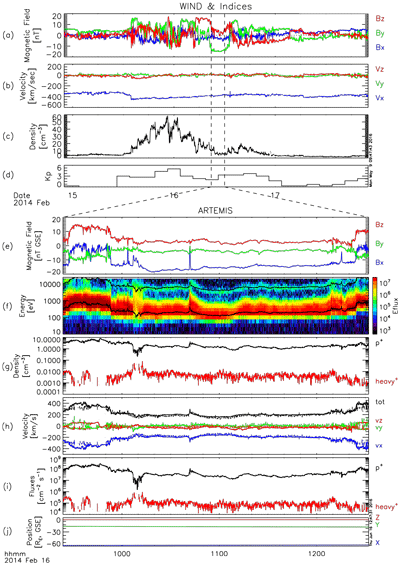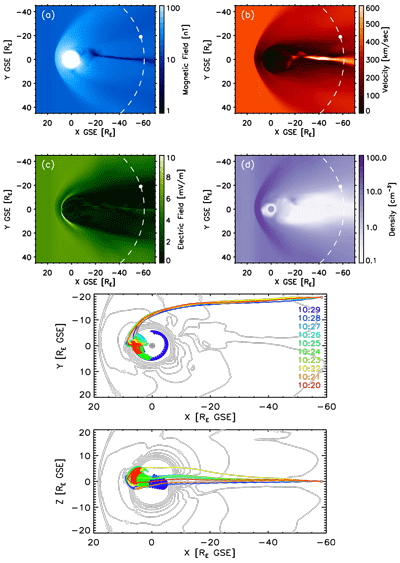2016 ARTEMIS SCIENCE NUGGETS
ARTEMIS observations of terrestrial molecular ions at the Moon
by A. R. Poppe,
Space Sciences Laboratory, U.C. Berkeley
Introduction
Both the solar wind and the terrestrial ionosphere contribute plasma to the terrestrial magnetosphere. The solar wind can provide protons and alpha particles (doubly-charged helium) while the terrestrial ionosphere serves as a source of protons, singly-charged helium, oxygen ions, and occasionally, heavier molecular ions such as N2+, NO+, or O2+. While atomic oxygen ions have been routinely observed and characterized inside Earth's magnetosphere, observations of molecular ions are much more rare. Present knowledge indicates that outflow of molecular ions is strongly associated with high levels of geomagnetic activity; however, much of the subsequent molecular ion dynamics within the magnetosphere, including the eventual loss of these ions, is unclear. Here, we report and analyze two observations of molecular ion outflow observed by ARTEMIS at lunar distances down-tail in the terrestrial magnetotail. To investigate the dynamics and origins of these molecular ions, we have used a global magnetohydrodynamic model of the Earth's magnetosphere (the Open General Geospace Circulation Model, OpenGGCM) to define the magnetospheric electromagnetic fields and perform backwards ion tracing from the ARTEMIS position to the inner magnetosphere.
Observations
Figure 2 shows Wind and ARTEMIS observations on February 15-17, 2014. The upper four panels show the (a) interplanetary magnetic field (IMF), (b) solar wind velocity, (c) solar wind density, and (d) Kp index, respectively for three full days. The IMF, solar wind velocity, and solar wind density were all observed upstream of Earth's magnetosphere by the Wind spacecraft. Starting around 15 Feb 2014 / 12:00, an interplanetary shock and coronal mass ejection pass the Wind spacecraft and strike the Earth's magnetosphere. This triggers a geomagnetic storm, as seen in the elevated Kp index lasting through 17 Feb 2014.
| Figure 1. Artist depiction of the magnetosphere viewed from above Earth, with the sun on the left and moon on the right. The magnetosphere is compressed due to increased solar wind pressure, and the colored lines show modeled paths of ions escaping Earth's ionosphere and traveling along the magnetopause to be ultimately detected by ARTEMIS at the moon. Credit: E. Masongsong, UCLA EPSS |
During the sub-interval 16 Feb 2014 09:00 – 12:30, denoted by the vertical dashed lines, we also show ARTEMIS observations downstream at lunar distances in the terrestrial magnetotail: (e) the magnetic field, (f) the ion energy flux, (g) the density, (h) the velocity, (i), the plasma flux, and (j), the lunar position in GSE coordinates. Shown in panel 1(f), ARTEMIS observes two separate ion populations correlated in energy: a broad peak at lower energies and a narrow (i.e., cold) beam at approximately 28-32 times the energy of the lower beam. While the ARTEMIS ESA instrument does not possess mass discrimination capability, we can nevertheless conclude with fairly strong certainty that the cold ion beam is a mixture of heavy ions with masses of approximately 28-32 amu. These masses correspond to terrestrial molecular ion species N2 +, NO +, and O2 +, all of which have been previously (although relatively rarely) observed in the inner terrestrial magnetosphere. These new ARTEMIS observations add an exciting new way to characterize and understand the dynamics of terrestrial molecular ions in the magnetosphere.
| Figure 2. A combined observation of both Wind and ARTEMIS. The Wind data (upper panels) show the upstream solar wind properties for the time period 15-18 Feb 2014, showing the presence of a significant interplanetary shock and coronal mass ejection. In the sub-interval 16 Feb 2014 / 09:30 – 12:30 (denoted by the dashed lines), we also show ARTEMIS observations downstream in the terrestrial magnetotail. The ARTEMIS observations include the magnetic fields, ion energy flux (showing both a warm, low-energy proton component, and a cold, higher-energy molecular ion beam), as well as partial moments (density, velocity, flux) for both the proton and molecular ion components. |
Modeling
In order to full understand the origin of these molecular ions and their dynamics within the terrestrial magnetosphere during this time, we have employed a global magnetohydrodynamics (MHD) model of the Earth's magnetosphere to simulate the time period during the ARTEMIS observations. The MHD model, OpenGGCM, uses real-time upstream solar wind data as input into the model in order to capture the fully time-dependent nature of the solar wind-terrestrial interaction. A snapshot of the MHD results is shown in Figure 3(a-d) including the magnetic field, plasma velocity, electric field, and plasma density. Earth is located at [0,0] RE, the lunar orbit is denoted by the white dashed line, and the location of the Moon and ARTEMIS probes during this time is denoted by the white dot at approximately X=-55 RE downstream. By comparing the MHD results to the in-situ ARTEMIS observations, we found that the model closely matched the background electric and magnetic fields as observed by ARTEMIS (shown in the manuscript).
| Figure 3. The upper four panels show results from the global MHD model OpenGGCM of the magnetic field, velocity, electric field, and plasma density, of the terrestrial magnetosphere during the 16 Feb 2014 event. The lunar orbit and the Moon are denoted by the dashed white line and white dot, respectively. The lower two panels show representative results of the molecular ion tracing exercise in the GSE X-Y and GSE X-Z planes, respectively. Molecular ions undergoing bounce and drift motion in the inner magnetosphere are "shadowed" near the sub-solar point and lost to the low-latitude boundary layer, where they are entrained in the dawnward and tailward flow, to be later observed by ARTEMIS at the Moon. |
Thus, using these background fields, we traced the trajectories of individual molecular ions backwards in time from their observation by ARTEMIS. The lower two panels in Figure 3 show the results of this tracing exercise in two different planes: GSE X-Y and GSE X-Z. Various colors denote individual ions launched at different times from ARTEMIS. The tracing model shows that the molecular ions were at one point trapped inside the inner magnetosphere between 5-7 RE undergoing bounce and drift motion. As the molecular ions approached the sub-solar point, they drifted into the low-latitude boundary layer (LLBL), began to undergo non-adiabatic motion, and were eventually entrained in the dawnward and tailward LLBL flow to be observed at lunar downtail distances by ARTEMIS. Thus, this exercise reveals an important loss channel for terrestrial molecular ions, one that has not fully been previously explored.
| Figure 4. Open GGCM animation based on Fig. 3a. |
Conclusion
These ARTEMIS observations of terrestrial molecular ions add a new and exciting method of understanding the production, circulation, and loss of ionospheric plasma. Previous observations of terrestrial molecular ions have indicated that their production is closely tied to strong geomagnetic disturbances; however, both the ultimate driving mechanism(s) and the subsequent behavior of these ions and their potential effects on magnetospheric dynamics is poorly understood. While we have only presented two individual observations of molecular ion outflow at the Moon in the main paper, we have already begun identify more than two-dozen additional events with which to statistically study and understand molecular ion behavior.
Finally, these ions also have an impact on the Moon itself. When these ions impact the solid surface of the Moon, they carry enough momentum to sputter (i.e., eject) neutral lunar atoms from the lunar soil, contributing significantly to the density of the lunar exosphere (estimates in the paper show that the molecular ions can contribute an equal amount of sputtered neutrals as do the concurrently present proton flux). The nitrogen and oxygen composition of these molecular ions is also significant, because both species are important volatile species at the Moon that may eventually migrate across the lunar surface and be trapped within polar cold trap regions for millennia or more. Thus, it seems quite possible based on these ARTEMIS observations that significant amounts of terrestrial atmosphere have found their way to a near permanent home on the Moon. Further work will aim to more accurately quantify the influx and subsequent behavior of these molecules within the lunar environment.
References
Poppe, A. R., M.O. Fillingim, J. S. Halekas, J. Raeder, and V. Angelopoulos, ARTEMIS observations of terrestrial molecular ion outflow at the Moon, Geophys. Res. Lett., 43, 2016.Biographical Note
Andrew Poppe is an Assistant Research Scientist in the Space Physics Research Group at the Space Sciences Laboratory / UC Berkeley. His research includes analysis of ARTEMIS data regarding solar wind and terrestrial magnetotail interactions with the Moon, as well as modeling and data comparison of interplanetary and planetary dust dynamics. See http://research.ssl.berkeley.edu/~poppe/ for more information.
 Please send comments/suggestions to
Emmanuel Masongsong / emasongsong @ igpp.ucla.edu
Please send comments/suggestions to
Emmanuel Masongsong / emasongsong @ igpp.ucla.edu


